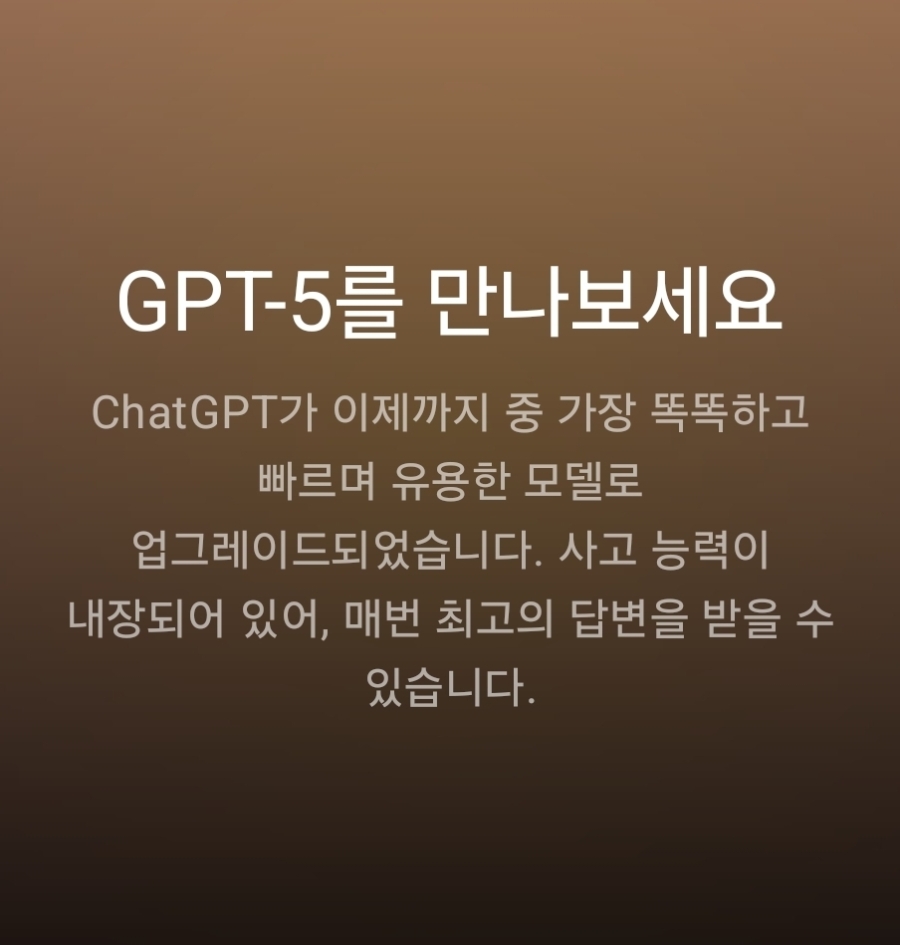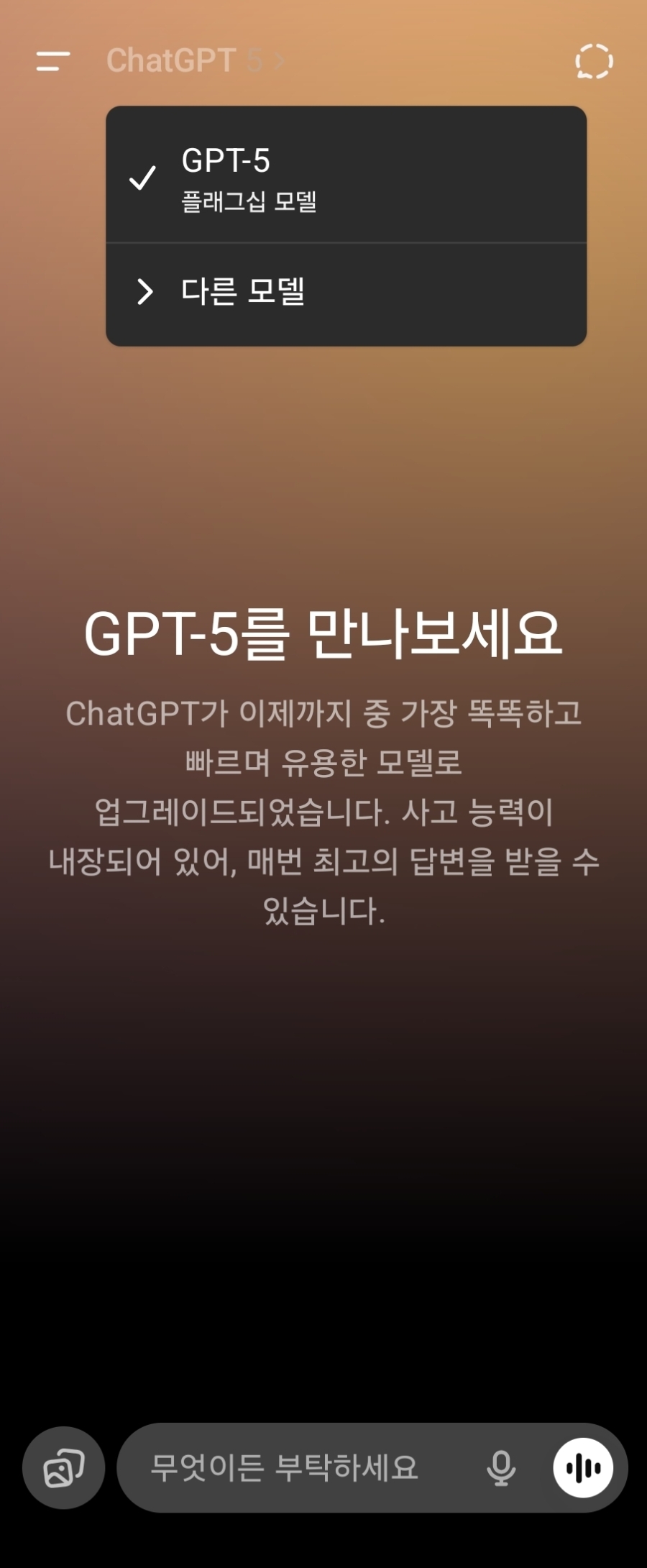Table of Contents
- GPT-5: Another Evolution in Artificial Intelligence Technology
- Significant Performance Enhancements from Multimodal to Coding, Creation, and Healthcare
- Achieving Safety and Flexibility – Introduction of Safe-Completions
- Pricing Plans and API Provisioning
- GPT-5 is Not Just an Upgrade
- Frequently Asked Questions (FAQ)
GPT-5: Another Evolution in Artificial Intelligence Technology

On August 7, 2025, OpenAI officially unveiled GPT-5 in the United States. Starting from the morning of August 8 in Korea, the new model began to be implemented in ChatGPT and the OpenAI API. This GPT-5 goes beyond simple performance enhancement, realizing the innovative concept of 'an AI that thinks and decides independently,' gathering significant attention.

GPT-5 introduces a routing architecture that allows for real-time switching between two models: a basic model that processes standard responses quickly and the GPT-5 Thinking model that deeply analyzes complex problems. This system independently selects and provides the optimal response method without special instructions from users, enabling a faster, deeper, and more practical AI experience.
These technological advancements maximize the convenience of AI users and establish a foundation for efficiently responding to diverse needs.
Significant Performance Enhancements from Multimodal to Coding, Creation, and Healthcare
The core of GPT-5 shines in three practical areas.

The first point to mention is the improvement in coding performance. It has shown an accuracy of 74.9% in SWE-bench Verified and 88% based on the code editing-focused Aider polyglot, significantly increasing its practical applicability in software development. Performance improvements are notable in various processes including code generation, modification, and refactoring.

Secondly, the capability to assist in writing and creation has improved. GPT-5 harmonizes rhythm and logic well in scenario writing, long-form writing, and poetry creation, increasing its potential as a tool for collaboration with creators.

Thirdly, in the healthcare field, response quality has improved. It is now capable of providing clearer answers and user-centered information regarding health-related inquiries. However, it focuses more on auxiliary roles rather than replacing medical professionals.
Achieving Safety and Flexibility – Introduction of Safe-Completions

GPT-5 moves away from the previous unconditional rejection method, adopting a new safety-focused training approach called 'Safe-Completions.'
Rather than merely rejecting dangerous questions, it aims to provide safer and more beneficial information.
In high-risk fields such as biology or chemistry, a multilayered response system considering 'High' capabilities is established, allowing for more reliable information delivery.
Pricing Plans and API Provisioning

GPT-5 is being gradually made available to users of the ChatGPT Plus, Pro, Team, and Free plans, with Pro plan users having virtually unlimited access.
For Free plan users, GPT-5 can be used, but if the set usage limit is exceeded, it automatically switches to GPT-5 mini.
The OpenAI API offers four models for developers: gpt-5 boasts the best performance, while gpt-5-mini is suitable for users who prioritize speed and cost-effectiveness. Additionally, gpt-5-nano is offered at a very low price, and gpt-5-chat-latest is the basic chat model for ChatGPT.
This variety of models expands the selection options to meet user needs.

The pricing structure for GPT-5 is set at $1.25 for input and $10 per million tokens for output. Nano is relatively inexpensive at $0.05 for input and $0.40 for output. Furthermore, GPT-5 can process up to 400,000 tokens, making it very useful for writing long documents, code, and technical reports.
GPT-5 is Not Just an Upgrade

The unveiling of OpenAI's GPT-5 signifies a new stage beyond mere performance improvement, where AI can make autonomous judgments and engage in deep thinking. In ChatGPT, the base model has been changed to GPT-5, with users able to choose to use the GPT-5 Thinking model according to their needs. This change will further expand the potential applications of AI.

The newly restructured AI model is designed to provide practical value for developers, creators, and general users. It is applicable in various fields such as coding, creation, and information retrieval, and has established itself as a next-generation AI system that also considers safety and usability flexibility.
GPT-5 has garnered attention not merely for being "smarter," but for presenting the new perspective of "an AI that engages in deeper thinking when needed." This change significantly broadens the role of AI and increases its applicability across diverse areas.
#GPT5, #OpenAI, #AI updates, #GPT5Thinking, #AI coding, #GPT5 official release, #ChatGPT, #AI creation, #multimodal AI, #GPT5 performance, #API utilization, #artificial intelligence, #GPT model comparison, #AI news, #coding assistant, #generative AI, #safe AI, #healthcare AI, #GPT API, #AI tool recommendations, #AI developer, #ChatGPT Plus, #GPT5 pricing, #GPT5 mini, #AI technology, #AI output control, #Reasoning Effort, #GPT5 nano, #long document AI, #AI usage methods
Frequently Asked Questions (FAQ)
Q. What new architecture has GPT-5 introduced?
GPT-5 has introduced a routing architecture that allows real-time switching between the base model and the Thinking model.
GPT-5 has introduced a routing architecture that can switch in real-time between two models: the basic model for fast responses and the GPT-5 Thinking model for in-depth analysis. This system independently selects the optimal response method without separate instructions from users, thereby providing a faster, deeper, and more practical AI experience. This maximizes the convenience for AI users and establishes a foundation for effectively responding to diverse needs.
Q. What are the main areas of performance improvement for GPT-5?
Coding, creation, and healthcare are three areas where GPT-5 has significantly improved its performance.
Firstly, coding performance has improved significantly, achieving 74.9% accuracy in SWE-bench Verified and 88% in Aider polyglot, increasing its practical applicability in software development. It performs excellently in various tasks, including code generation, modification, and refactoring. Secondly, the capability to assist in creation has improved, excelling in scenario writing, long-form writing, and poetry creation, and gaining acclaim as a tool for collaboration with creators. Lastly, in healthcare, the quality of responses has improved, providing clearer user-centered answers and fulfilling an auxiliary role.
Q. What safety enhancement features are included in GPT-5?
GPT-5 has enhanced safety and flexibility with the 'Safe-Completions' training method.
Moving away from the previous unconditional rejection of questions, GPT-5 has introduced a new safety-focused training method called 'Safe-Completions.' It focuses on providing safer and more beneficial information in response to dangerous questions. Particularly in high-risk areas such as biology and chemistry, a multilayered response system has been established to provide reliable information. This has simultaneously enhanced the safety and flexibility of AI responses.
Q. How are the pricing plans and API model structures for GPT-5 configured?
GPT-5 meets user needs with various pricing plans and four API models.
GPT-5 is gradually provided to users of the ChatGPT Plus, Pro, Team, and Free plans. Pro plan users have virtually unlimited access, while Free plan users automatically switch to GPT-5 mini if they exceed the set usage limit. The API offers four models: gpt-5 (highest performance), gpt-5-mini (focusing on speed and cost-effectiveness), gpt-5-nano (low-cost), and gpt-5-chat-latest (the basic chat model), thus broadening the options available to meet diverse user needs.
Q. How does GPT-5 differ from existing models?
GPT-5 is an innovative AI that enables autonomous reasoning and decision-making, surpassing previous models.
GPT-5 goes beyond simple performance improvements, opening up a new stage where AI can make autonomous judgments and engage in deep reasoning. The base model has been changed to GPT-5 in ChatGPT, and users can choose to use the GPT-5 Thinking model as needed. This capability for deeper reasoning when required marks a significant innovation that greatly expands the potential applications and roles of AI in various fields.